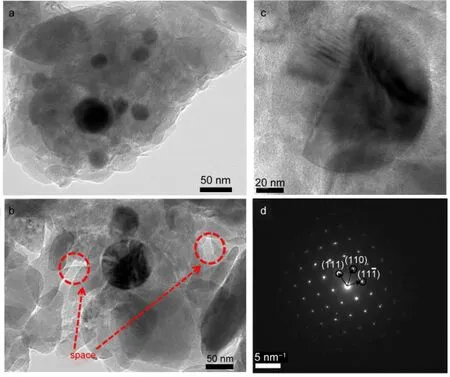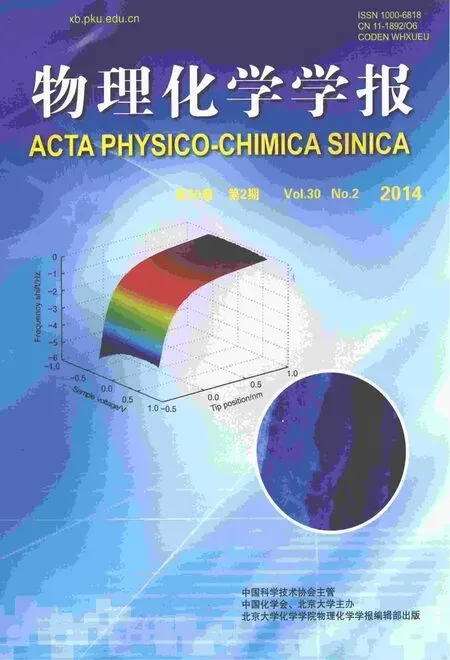Si-O-C骨架支撑型高循环性能锂离子电池硅基负极材料
2014-06-23王建涛杨娟玉卢世刚
王建涛 王 耀 黄 斌 杨娟玉 谭 翱 卢世刚
(北京有色金属研究总院动力电池研究中心,北京100088)
1 Introduction
Low-or zero-emission hybrid electrical vehicles(HEVs)and electrical vehicles(EVs)have great potential to reduce the energy crisis and environmental aspects,such as air pollution,dust particle contamination and so on,which come from the use of fossil fuels.It is necessary to develop high-energy-density and long cycle lithium(Li)-ion batteries so as to meet the requirements set for electric vehicles.1-6
Increasing the specific capacity of Li-ion battery anodes is considered to be an attractive route to attain this goal.7-13
Silicon(Si)is a promising anode material for high-energydensity Li-ion batteries because of its high theoretical Li-ion storage capacity(~4200 mAh·g-1,372 mAh·g-1for conventional graphite anodes)and low discharge potential.
However,the applications of silicon in Li-ion batteries have been limited due to its low cycling stability,which was caused by the large volume change(>300%)during the lithiation and delithiation processes.It is demonstrated that the large volumechange led to the pulverization of Si structure,electrical disconnection from the current collector,and eventual capacity fading.14In addition,the rate capacity of Si based anode materials is not satisfied due to its low electrical conductivity.
Considerable efforts have been made to overcome these problems by using composite materials.15-22When the Si nanostructures uniformly dispersed among the cushioning materials,the cycling stability of Si-based anodes had been greatly improved by minimizing the total volumetric expansion to accommodate expansion.However,with the increase of the cycle number,Si nanostructures would peel from the cushioning materials because of different coefficients of expansion between various materials.As a result,the cycling stability of composite materials is still not satisfied.
Herein,we developed a Si/SiOC/graphite(SSG)structured composite to overcome the existing challenges.In this composite,a SiOC net structure,which is demonstrated that this material has highly cycling stability,23-25is introduced into the system to avoid the Si conglomeration and improve the cycling stability.The chemical bonding between Si nanostructures and SiOC skeleton could limit the segregation of Si particles during the lithiation and delithiation processes.The graphite is used as conductive material to enhance the electrical conductivity.As a result,the SSG composite anode exhibits excellent long-term cycling stability and capacity.
The concept of using highly stabile SiOC skeleton-supported Si nanostructures opens a new route for anodes with long cycling stability and excellent capacity.In this structure,Si nanostructures were embedded in the SiOC skeleton with―O―Si―O― chemically bonded.The specific nanostructures effectively prevent the aggregation of Si nanostructures and accommodate expansion during the lithiation and delithiation processes.Consequently,the possibility of peeling between Si and skeleton is reduced and better cycling stability is acquired.The SSG composite exhibits an improved reversible capacity of 548.1 mAh·g-1after 100 cycles and an average capacity fading of 0.12%.The design of this new structure has the potential to provide a way for other functional composite materials.
2 Experimental
2.1 Surface coating of Si nanostructure and curing crosslinking of organosiloxane
1 g of Si nanoparticles(30 nm,Beijing Deco Island Gold Science and Technology Co.,Ltd.)was dispersed into 20 g of Vinyltris(2-methoxy-ethoxy)silane and then sonicated for 30 min to achieve a liquid suspension.Afterward,2 mL water and 2 mL ethanol were added to the suspension and then stirred for 2 h.Then 15 mL of phenolic resin ethanol solution(50%,mass fraction),10 g hydrogen-containing polysiloxane,and 0.4 g Pt[(ViMe2Si)2O][ViMe2SiOSiMe2OH]were mixed with the above Si suspension and stirred strongly for 2 h.The above mixture suspension was dried at 80°C for 2 h under H2(5%,volume fraction)/Ar(95%,volume fraction)atmosphere to ensure the mixture cure.
2.2 Solid-phase reaction
The curing result was pyrolysis,followed by reduction in a crucible in a tube furnace at 1000°C for 2 h under H2(5%)/Ar(95%)atmosphere with a heating rate of 10 °C·min-1,treated with crushing to finally obtain Si/SiOC/G composites.
2.3 Fabrication of SiOC composite
The process of fabrication of the SiOC is the similar as the way of the SSG composite.The difference of the experimental details is the species of the raw materials as follows:for SiOC composite,both the Si nanoparticles and phenolic resin ethanol solution were not added to the mixing solution.
2.4 Structural and electrochemical characterizations
Scanning electron microscope (SEM) was conducted on aHitachi S- 4800 scanning electron microscope operated at 10kV.Energy dispersive X-ray spectroscopy (EDX) analysis wascarried out with an EDAX system attached to the microscope.Transmission electron microscope (TEM) and high resolutiontransmission electron microscopy (HRTEM) were performedusing a JEOL JEM- 2010F transmission electron microscopeoperated at 200 kV.X- ray diffraction (XRD) measurementswere manipulated on a PANalytical/X Pert PRO MPD diffractometerusing CuKαradiation.Electrochemical experiments were performed using coin cells.The discharge and charge measurements of the batteries were performed on a Land CT2001A electrochemical test system in the fixed voltage window between 0.05 and 2 V at room temperature.To prepare Si,SiOC,and Si/SiOC/G electrodes,we mixed the active materials,poly-vinylidenefluoride(PVDF),and Super-P with a mass ratio of 70:15:15 into homogenizer and stirred strongly.Then,the obtained slurry was pasted onto pure Cu foils(99.9%,Hitachi).The loading of active materials is about 3 mg·cm-2.The electrolyte was LiPF6(1 mol·L-1)in ethylene carbonate/dimethyl carbonate(EC/DMC)(1:1,V/V)solution(Tianjing Jinniu Power Sources Material Co.Ltd.)plus 2%(mass fraction)vinylene carbonate(VC).
3 Results and discussion
Fig.1 shows the schematic diagram of the synthesis process of SSG composite.The fabrication of the SSG composite involves three steps.First,nano-sized Si,organosilane,and water were mixed in an appropriate ratio to form the Si nanostructure modified by organosilane through the ultra-sonication way(Fig.1).Second,SiOC precursor was achieved by cross-linking with the role of curing agent and catalyst.Si nanostructures were embedded in the precursor skeleton by chemical bonds,which could not only effectively avoid the congestion of Si nanostructure,but also reduce the possibility of dissociation between Si and skeleton during charge/discharge processes.Finally,composite was synthesizedviapyrolysis process.In this process,excess branched chains and dangling bonds could be removed and some space could be generated to accommodate expansion during the process of lithiated and delithiation.

Fig.1 Schematic illustration of preparation of the Si/SiOC/G composite

Fig.2 Transmission electron microscope(TEM)(a-c)and selected area electron diffraction(SAED)(d)images of the Si/SiOC/G composite
As shown in Fig.2a,the Si nanoparticles were embeded in the amorphous SiOC skeleton.Some space could be observed in the composite(Fig.2b).The high resolution transmission electron microscopy of the Si particle is shown in Fig.2c.SAED image of Si particle suggests that the Si particles still retain the mono-crystal state.
The SEM images of the Si/SiOC/G composite are shown in Fig.3.The size of the composite is relatively uniform and a few nanoparticles are arranged on the surface of the composite.The SEM image and energy dispersive X-ray spectroscopy(EDX)mappings clearly show that the Si element uniformly distributed in the material(Fig.S1 in Supporting Information).The thickness of the electrode is approximately 85 μm before electrochemical charge and discharge(Fig.S2).
The EDX measurement confirms the existence of elements Si,O,and C in the SSG composite and their atom ratios are approximately 22.34%,18.18%,and 59.58%(Fig.3d).The crystalline structures of the precursors and SSG composites with different compositions were characterized by X-ray diffraction(Fig.4).In the SiOC structure,only a broad peak appeared around 22°,that was ascribed to SiOx.Besides the broad peak,a tiny peak around 26°and a small peak around 44°were observed in the composite,which were the peaks of graphite.Si and graphite peaks are indexed in the SSG composites,whichmeans that Si nanoparticles remain crystalline in the SSG composite after sonication,modification,and heat treatment.

Fig.3 Scanning electron microscope(SEM)images(a-c)and energy dispersive X-ray(EDX)spectrum(d)of the Si/SiOC/G composite

Fig.4 X-ray diffraction patterns of Si nanoparticles(a),SiOC(b),SiOC/G(c),Si/SiOC(d),and Si/SiOC/G(e)composites
Fig.5a shows the discharge-charge profiles of the first two cycles of the Si/SiOC/G composite at 0.3C(1C=1 A·g-1)between the voltage limits of 0.05-2.0 V(vsLi/Li+).The initial discharge and charge capacities are 637.3 and 1156.6 mAh·g-1,respectively,leading to columbic efficiency of about 55.17%.The irreversible capacity loss of the Si/SiOC/G composite can be ascribed to the formation of the solid electrolyte interface(SEI)and the existence of SiOC skeleton.The initial discharge and charge capacities,and columbic efficiency of SiOC skeleton material are 857.9 mAh·g-1,424.2 mAh·g-1,and49.4%,respectively(Fig.5b).Compared with SiOC skeleton material,the increasing for the first columbic efficiency of Si/SiOC/G is attributed to the Si active constituent.The Si active constituent has a higher first columbic efficiency than SiOC without considering the influence of its aggregation.The columbic efficiency becomes stable after the first three cycles.

Fig.5 Electrochemical performance of Si,SiOC,and Si/SiOC/G with the same conditions
As shown in Fig.5b,the Si/SiOC/G composite exhibits excellent cycling performance.On one hand,the reversible capacity and the capacity retention rate of Si/SiOC/G composite were 548.1 mAh·g-1and 86%even after 100 cycles.This is equivalent to a specific capacity of 3246 mAh·g-1after 100 cycles based on Si mass(the reversible capacities of SiOC and SiOC/G are 432 and 406 mAh·g-1at the 100th cycle).The average discharge capacity loss over 100 cycles is only~0.16%per cycle based on the initial specific capacity of silicon(3800 mAh·g-1).On the other hand,to show the advantage of the Si/SiOC/G composite,we compared the cycling performances of Si/SiOC/G,SiOC,and Si nanoparticles under the same conditions.Electrochemical test results indicate that the Si nanoparticle electrode exhibits a rapid capacity fading(Fig.5b).The rapid capacity fading could be attributed to the large volume changes of these aggregated Si nanoparticles during Li insertion and extraction processes,leading to an electrical disconnection among nanoparticles.The SEM images of the Si nanoparticle electrode after cycling showed that the materials were peeled from the collector in the supporting information(Fig.S3).On contrast,the electrode based on the SiOC skeleton has the good capacity retention rate due to its stable physical and chemical properties,which could be further confirmed from the side view image of the SSG after cycling(Fig.S1a).Compared with the SiOC electrode,Si/SiOC/G electrode shows better capacity and the similar cycle performance.In the Si/SiOC/G system,acting as an electrochemical active site,Si is used to adjust the electrochemical specific capacity,SiOC skeleton is used to ensure the cycling stability of the composite,and graphite acts as a conductive component to improve the electron transmission performance during the process of the charge/discharge.
4 Conclusions
In summary,the electrode performance of silicon as an anode for Li-ion battery has been largely improved through introducing a stable SiOC skeleton structure and conductive graphite.The SiOC skeleton prevents the aggregation of Si nanoparticles and accommodates large volume changes of Si nanoparticles in the processes of lithiation and delithiation.The graphite acquired from the pyrolysis of resin acts as conductive component,which enhances the electrical connection between Si nanoparticles and SiOC skeleton.The as-obtained Si/SiOC/G composite exhibits improved cycling stability(only 14%capacity loss over 100 cycles).The approach,which used stable Si-OC structure as skeleton to form a stable Si-based composite,can be a simple,yet very cost-effective for extensively fabricating high performance anode materials for Li-ion batteries.Owing to its versatility,the approach reported in this work could also be extended to other stabilize functional composites with large volume changes during physical,chemical,or electrochemical operations.
Supporting Information:The images of electrode pad after cycles from side view and top view,and EDX mapping of silicon,oxygen,carbon,and copper of the electrode pad are shown in Fig.S1.The image of SSG electrode pad before cycles from side view is shown in Fig.S2.Images of nano-Si particle electrode pad after cycles from side view and top view are shown in Fig.S3.Electrochemical performance with more numbers for SiOC is shown in Fig.S4.This information is available free of chargeviathe internet at http://www.whxb.pku.edu.cn.
(1)Armand,M.;Tarascon,J.M.Nature2008,451,652.doi:10.1038/451652a
(2) Maier,J.Nat.Mater.2005,4,805.doi:10.1038/nmat1513
(3) Kang,B.;Ceder,G.Nature2009,458,190.doi:10.1038/nature07853
(4) Arico,A.S.;Bruce,P.;Scrosati,B.;Tarascon,J.M.;Schalkwijk,W.V.Nat.Mater.2005,4,366.doi:10.1038/nmat1368
(5)Wu,H.B.;Zhang,Y.;Yuan,C.L.;Wei,X.P.;Yin,J.L.;Wang,G.L.;Cao,D.X.;Zhang,Y.M.;Yang,B.F.;She,P.L.Acta Phys.-Chim.Sin.2013,29,1247.[武洪彬,张 莹,袁聪俐,韦小培,殷金玲,王贵领,曹殿学,张益明,杨宝峰,佘佩亮.物理化学学报,2013,29,1247.]doi:10.3866/PKU.WHXB201303211
(6) Ding,P.;Xu,Y.L.;Sun,X.F.Acta Phys.-Chim.Sin.2013,29,293.[丁 朋,徐友龙,孙孝飞.物理化学学报,2013,29,293.]doi:10.3866/PKU.WHXB201211142
(7) Chan,C.K.;Peng,H.L.;Liu,G.;Mcilwrath,K.;Zhang,X.F.;Huggins,R.A.;Cui,Y.Nature Nanotech.2008,3,31.doi:10.1038/nnano.2007.411
(8) Poizot,P.;Laruelle,S.;Grugeon,S.;Dupont,L.;Tarascon,J.M.Nature2000,407,496.doi:10.1038/35035045
(9) Taberna,L.;Mitra,S.;Poizot,P.;Simon,P.;Tarascon,J.M.Nat.Mater.2006,5,567.doi:10.1038/nmat1672
(10)Oumellal,Y.;Rougier,A.;Nazri,G.A.;Tarascon,J.M.;Aymard,L.Nat.Mater.2008,7,916.doi:10.1038/nmat2288
(11) Jiang,D.D.;Fu,Y.B.;Ma,X.H.Acta Phys.-Chim.Sin.2009,25,1481.[姜冬冬,付延鲍,马晓华.物理化学学报,2009,25,1481.]doi:10.3866/PKU.WHXB20090817
(12)Fan,X.Y.;Zhuang,Q.C.;Wei,G.Z.;Ke,F.S.;Huang,L.;Dong,Q.F.;Sun,S.G.Acta Phys.-Chim.Sin.2009,25,611.[樊小勇,庄全超,魏国祯,柯福生,黄 令,董全峰,孙世刚.物理化学学报,2009,25,611.]doi:10.3866/PKU.WHXB20090403
(13) Li,Y.;Xie,H.Q.;Tu,J.P.Acta Phys.-Chim.Sin.2009,25,365.[黎 阳,谢华清,涂江平.物理化学学报,2009,25,365.]doi:10.3866/PKU.WHXB20090229
(14)Kasavajjula,U.;Wang,C.;Appleby,A.J.J.Power Sources2007,163,1003.doi:10.1016/j.jpowsour.2006.09.084
(15) Hu,Y.S.;Demir-Cakan,R.;Titirici,M.M.;Müller,J.O.;Schlögl,R.;Antonietti,M.;Maier,J.Angew.Chem.Int.Edit.2008,47,doi:1645.doi:10.1002/anie.200704287
(16)Ng,S.H.;Wang,J.;Wexler,D.;Konstantinov,K.;Guo,Z.P.;Liu,H.K.Angew.Chem.Int.Edit.2006,45,6896.doi:10.1002/anie.200601676
(17) Dimov,N.;Kugino,S.;Yoshio,M.Electrochim.Acta2003,48,1579.doi:10.1016/S0013-4686(03)00030-6
(18)Lee,J.K.;Smith,K.B.;Hayner,C.M.;Kung,H.H.Chem.Commun.2010,46,2025.doi:10.1039/b919738a
(19)Zhou,X.;Yin,Y.X.;Wan,L.J.;Guo,Y.G.Chem.Commun.2012,48,2198.doi:10.1039/c2cc17061b
(20) Xiang,H.;Zhang,K.;Ji,G.;Lee,J.Y.;Zou,C.;Chen,X.;Wu,J.Carbon2011,49,1787.doi:10.1016/j.carbon.2011.01.002
(21) Liu,Y.;Matsumura,T.;Imanishi,N.;Hirano,A.;Ichikawa,T.;Takeda,Y.Electrochem.Solid-State Lett.2005,8,A599.doi:10.1149/1.2039954
(22)Yu,Y.;Gu,L.;Zhu,C.;Tsukimoto,S.;VanAken,P.A.;Maier,J.Adv.Mater.2010,22,2247.doi:10.1002/adma.200903755
(23) Hiroshi,F.;Hisashi,O.;Takakazu,H.;Kiyoshi,K.ACS App.Mater.Inter.2010,2,998.doi:10.1021/am100030f
(24) Hiroshi,F.;Hisashi,O.;Takakazu,H.;Kiyoshi,K.J.Electro.Society2011,158,A550.doi:10.1149/1.3567956
(25) Hiroshi,F.;Hisashi,O.;Takakazu,H.;Kiyoshi,K.J.Power Sources2011,196,371.doi:10.1016/j.jpowsour.2010.06.077
